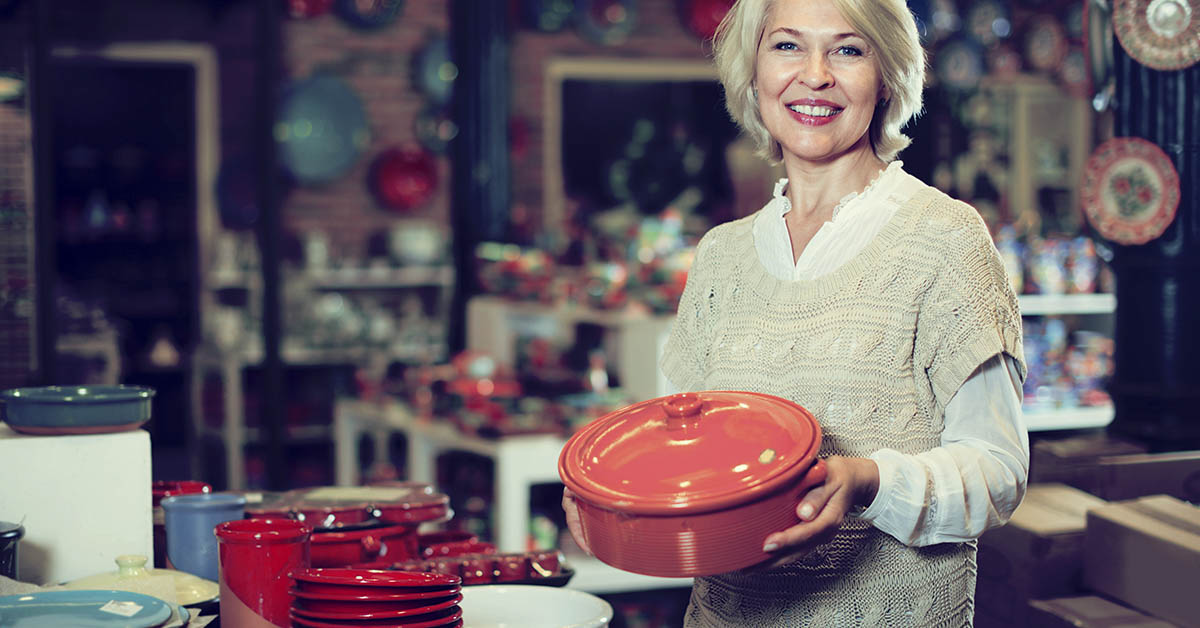Ceramic cookware seems to be all the rage nowadays. They look gorgeous with their colors and patterns. They can match different kitchen aesthetics with pretty pastels, bold jewel tones, and retro-inspired shades. But aside from looking attractive and aesthetically pleasing, how do they compare to other materials like stainless steel and cast iron? Ceramic comes with its own set of pros and cons, and they might be just right for your cooking needs.
What is ceramic cookware?
Ceramic literally means “clay that has been hardened,” but there are two types of ceramic cookware. The first is made of 100% ceramic and the second is ceramic-coated over aluminum, copper, or stainless steel. The latter is often marketed as a lightweight and nontoxic alternative to Teflon nonstick pans. [1]
Enter ceramic cookware with their thin coating of silicon. Like Teflon, they require little to no oil to fry foods or sear meat, but without the potentially toxic effects. Plus, they are lighter, often easier to use, and offer more versatility. They also defy the expectation of being dainty and breakable, since they are sturdy and often contain a metal core. Their nonstick surface also makes this cookware easy to clean, even with sticky sauces and burned residue.
That is not the only distinction between ceramic cookware and other materials. Cast-iron, copper, and aluminum cookware can interact with acidic foods like vinegar and tomatoes and result in unappetizing colors and metallic flavors. With ceramic, metal never touches the food directly, so there’s no concern over an unwanted reaction.
Oven and stovetop
Not all ceramic cookware is alike, so it’s important to check if individual pots and pans are considered oven-safe and what’s the maximum heat they can withstand. Most ceramic pots and pans can go into an oven heated up to 500 degrees Fahrenheit. Most home ovens don’t go beyond 500 degrees in any event, so there’s no concern over putting in a pot of French onion soup or baking casseroles all in one frying pan. Bonus: Check the manufacturer’s instructions because ceramic cookware can also be microwave-safe and freezer safe.
Remember, ceramic can heat up slowly and evenly, so when it comes to stovetop cooking, you might want to test lower temperatures than you’d use for other types of cookware. Some brands recommend lower temperatures to help preserve the nonstick coating, but because of ceramic’s ability to conduct heat, this setting can be effective for most recipes.
How to care for ceramic cookware
Also, be cautious when it comes to caring for ceramic. Careless use can cause chipping, discoloration, and the deterioration of the nonstick coating. Avoid scraping and stirring them with metal utensils or sharp implements. Instead, opt for silicon or wooden spatulas and spoons, and so on. Additionally, don’t scrub the cookware harshly since this could weaken the nonstick layer and heighten the eventual risk of the pot cracking.
One of the greatest blessings of nonstick is how simple it is to wash up afterward. There’s no need to scrub until your arm gets sore. However, ceramic cookware lasts longer when it’s washed by hand with warm water, mild soap, and a soft sponge. A hard sponge, wired sponge, or harsh scrubbing could damage the surface of the pans. Check the manufacturer’s instructions before putting them in the dishwater.
Although ceramic cookware can get pricey, some sets are notably cheaper compared to a similar stainless steel set. But keep in mind cookware like the Always Pan are versatile and could be used to cook different types of dishes, making it more cost-effective than buying several pans and pots.
Overall, ceramic cookware is versatile, but they do excel in a few areas. For instance, they are ideal for dishes that cook on the stovetop and then in the oven. They also maintain heat very well, making them perfect for soups, sauces, and anything that requires simmering, boiling, or steaming. And because of the nonstick surface, they can sear meat beautifully and leave a golden roasted color on chicken and vegetables with minimal cooking oil. [2]
Keep Reading: Surprising Reason Why You Should Spread Salt Around Your House: 12 Healthy Uses for Salt
Sources
- “Ceramic cookware pros and cons to know before you buy.” Reviewed USA TODAY. Kalina Newman. March 28, 2023
- “What is ceramic cookware and do you need it?” SF Gate. Lizzy Briskin. June 29, 2021

